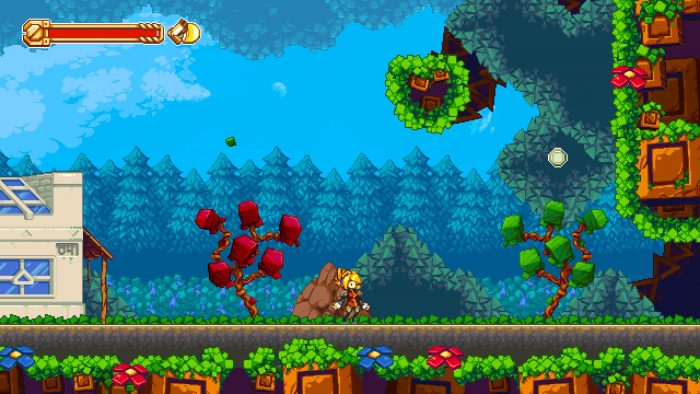Video games, like all media, directly reference and twist tropes from past pieces of work. To say that a video game has to be wholly unique is a redundant statement. Many of the games that we as fans and critics herald as “the best” are a part of a huge evolution that has taken place for almost four decades now. Along this long and wild ride there have been few games from indie to triple-A to ask the simple question of, “why do we do THIS,” and push back against the ingrained gaming tropes. Developer Konjack presents this idea through the Metroidvania genre with his aptly named new project Iconoclasts. The game is not only a direct answer to “why,” it’s more so firmly planting its foot down, drawing the line and giving a harsh rebuttal to every question gaming has presented in the genre.
Iconoclasts (i·con·o·clast – a person who attacks cherished beliefs or institutions) is about a female of uncertain age named Robin, who is an unlicensed mechanic. Her world is ruled by a tyrannical and religious government authority called One Concern. The government has made strict laws that only allow licensed mechanics to handle a special power source named Ivory. Things that Robin cares about begin to get destroyed by One Concern, and so she sets out to destroy them in return. Taking the meaning of the word “iconoclast” we can assume what follows.
I would be lying if I said the game didn’t surprise me, though. There are many moments throughout that have very real and succinct emotional depth to them, and the way Konjak is able to pull off the world building and story is impeccable. Everything from the graphics to the music feels meticulously hand crafted and perfected. Every platform, pixel, enemy and mechanic all have a reason to be there. Konjak didn’t spend 7 years of his life dedicated to this game to not make it come out being nothing short of a masterclass. Some of the more recent games with the biggest budgets can’t even hold a candle to what is executed in Iconoclasts.

There has been a recent trend with video games where developers are deciding that less is more, and Konjak reiterates that statement with a resounding “DUH”. Robin has a gun to shoot and a wrench to hit things, adjust things and swing across things. That’s it! So many of the set pieces, boss fights and puzzles are complex, but not because of the amount of items you have, but because of how much you can do within the area.
The Metroidvania genre requires players to search for item X in order to advance through one area, find item Y for the next area, possibly head back to search for item Z, and so on, usually through weapon upgrades. Iconoclasts has upgrades like that, sure, but most of the time progression is locked not behind an item wall but behind a story event or solving a puzzle. So much of the game’s mechanics feels like the creator is saying, “yeah but what if we did this instead?” and it’s wonderful. For example, Robin will automatically aim at enemies when shooting. So, instead of the process of running, stopping, shooting and then proceeding through the level, you can just run and gun through a screen without needing to pause. It makes the game feel fantastic while also making me wonder, “why hasn’t every Metroidvania done this”.
As a whole Iconoclasts is a very strong package, but two problems stick out. For all the systems that make the game more simplified, I feel that the Tweak system is overly complex for no reason. Tweaks give you small buffs like having more air when you swim, deflecting one hit or letting you spin your wrench longer than usual. As you explore the world you find items that you can use to craft Tweaks, with a lab table in each zone to make them. I can see why the system is in the game but I never really found the buffs to be something that were really ever needed in my playthrough. The second problem is the dialogue. Most of the time it’s actually very good but there are more than a few occasions where something just doesn’t feel right. Lines like: “I hope to die without unfinished business. My spirit lingering shouldn’t have to be a burden to my descendants.” and “I’M A PIECE OF CRAP, I GET IT” Reading it outloud is nothing short of a task and the mental olympics I had to jump through for other pieces of dialogue was kind of a bummer. For such a huge undertaking for one man there is bound to be places where a project will fall short, but thankfully Iconoclasts only has a few dents in its armor.

I’ve been following Konjak’s work over the last 8 years, a time span in which he’s released just two games. I absolutely adore 2009’s freeware release Legend of Princess, which put a spin on the Legend of Zelda series, for both gorgeous graphics and taking risks with the classic action genre. Little did I know that Legend of Princess would act as a catalyst for his next big project. The idea of taking something that is sacred and putting a new spin on it is what Konjak does best, and Iconoclasts is a testament to that. The game acts as a rebuttal, question of and definitive answer to the 2D platforming Metroidvania genre while still paying respect to the games that inspired it. The juggling that Konjak did to create this game is astonishing by itself but it’s complimented even more by the result which is an amazing experience.
This review is based on a retail Steam code sent by Konjak to the reviewer.

1 Comment